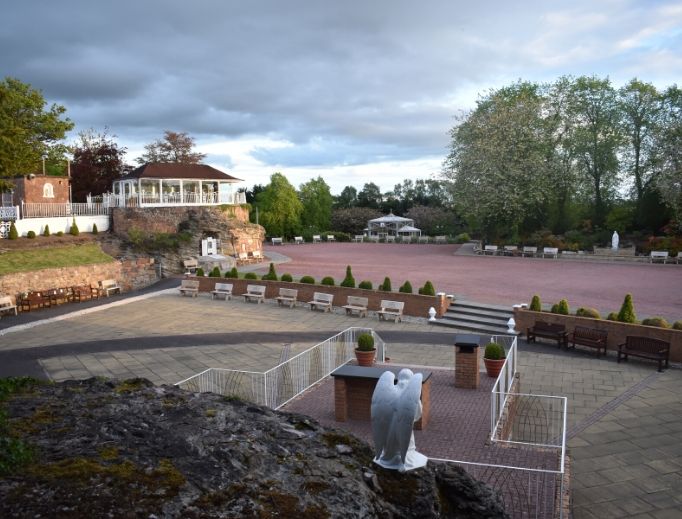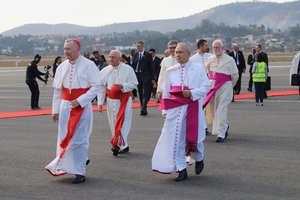Pilgrims Flock to ‘Scotland’s National Shrine to Our Lady’ During Lockdown
Present at Carfin is the ‘spirit of Lourdes’: healing through prayer.

Scotland’s National Shrine to Our Lady of Lourdes is at Carfin Grotto, in the parish of St. Francis Xavier in the village of Carfin, near Motherwell in North Lanarkshire.
Msgr. Thomas Taylor opened the shrine in 1922. At that time, many Scottish Catholics did not have the means to visit Marian shrines abroad, so Carfin Grotto was designed to be a place they could go on pilgrimage. Carfin comprises a church and extensive grounds, within which are different devotional grottos: to apparitions of Our Lady, to the saints, and to the life of Our Lord. The shrine welcomes 70,000-plus pilgrims annually from across the globe.
May 2020, however, sees the shrine’s activities curtailed because of the ongoing pandemic.
Father James Grant, the rector of the shrine, told the Register, “Since the lockdown, we have been unable to hold any services in the grotto. However, the grotto grounds remain open 24/7, which means that people are able to visit at any time of the day.” Surprisingly, he recounts how, during the lockdown, “there has never been a time — day or evening — when the grotto grounds have been empty. People are walking around, some obviously non-Catholics, using the beautiful surroundings to take their assigned exercise; others are Catholics, some of whom are regular visitors; others are visiting for the first time.”

During lockdown the shrine’s schedule is a daily Mass preceded by the Rosary, both livestreamed from the Blessed Sacrament Chapel in the shrine church, when around 450 people are present online; that number grows to almost 1,000 for Sunday Mass. Acts of private worship at the grotto continue, however: “Since the closure of our church, the grotto grounds is the only place where people can come and light a candle. We are going through hundreds of candles every week,” observed Father Grant.
In addition, after Saturday morning’s Mass there is a brief “para-liturgy,” when Father Grant lights candles for the specific intentions requested by people who have written to the shrine. “I do not read out the intentions, since some of them are very personal, but I give a summary of all the different intentions requested,” said Father Grant. “I say a decade of the Rosary and then call out the names of all those who have requested candles to be lit on their behalf. This has proved a very popular thing and is much appreciated by those unable to come to the grotto in person.”
Carfin Grotto is designed in such a way that the offering of Mass in the extensive open space adjacent to the shrine church is a normal feature of its program for large groups of pilgrims. Father Grant hopes that in due course it may be possible to offer Holy Mass in the open air again. This might “be one way of offering the Eucharist to people wary or nervous of worshipping with others in a much more confined space, such as inside a church. The grotto would be ideally suited to such a situation,” he added.
Although Carfin Grotto is commonly referred to as “Scotland’s National Shrine to Our Lady,” this has never been formally decreed by the Church. More correctly, it is the shrine attached to the parish of St. Francis Xavier, which was founded in Carfin in 1862, with the original parish church replaced in the early 1970s by the present building. The parish priest of Carfin automatically inherits responsibility for the grotto alongside his other parish duties; hence, he bears the additional title: “Guardian of the Grotto” or “Rector of the Grotto.”
Unlike the other better-known Marian shrines across the world, Carfin claims no apparitions.
“Carfin is very much a ‘local shrine,’” Father Grant explained. “It reflects the development of Catholicism in this area of Scotland over the last 150 years or so. The individual Lithuanian, Polish and Irish ‘shrines’ within the grotto grounds bear testimony to the nationalities that came to the industrial heartland of Scotland in search of work and who brought their Catholic faith with them.”
Sancta Familia Media (SFM) is a Catholic media apostolate started by John Mallon and Brian Timmons. “Our media work began just a few miles from the shrine in our home parish of Holy Family, Mossend,” Timmons told the Register, “but Carfin was where we expanded our work, [which is] simply presenting the beauty of the Catholic faith to a wider audience, [with Carfin Grotto] the perfect place to do this.”
As the centenary of the grotto’s founding approached, the Guardian of the Grotto asked SFM to spearhead the communications role at the grotto. Currently, SFM’s preparations for the forthcoming centenary of the Carfin shrine are in abeyance, however. Instead, from the beginning of the present lockdown, SFM has been livestreaming services from Carfin. “It has been a really strange experience,” Timmons explained, “as I have been so lucky to continue to attend Mass — while streaming — but there has been no congregation present in the church. And yet the virtual congregation has increased; many of those who watch live locally, but there are also people from all over the world tuning in as our ‘new congregation.’”
Just before the lockdown, SFM set out to promote Carfin Grotto on Facebook. In the space of just a few months, the shrine’s presence on that social-media platform has expanded rapidly to nearly 10,000 followers. Mallon told the Register the shrine’s current website and social-media presence has had “a massive spike in views and engagement, with over 1.1 million minutes viewed of live videos streamed from the shrine during lockdown and a nearly 40% increase in the shrine’s page followers.” But as Mallon pointed out, “It has not just been virtual pilgrims visiting the shrine. I have noticed the footfall there is very high, as many Catholics are seeking to fill the gap left by their closed churches. The grotto is open air and remains accessible, [while fulfilling government regulations on social distancing].” Timmons added, “People have appreciated all the more having the grotto on their doorstep. In this unprecedented time, with churches closed, people have been seeking somewhere to pray and feel connected to God. Carfin Grotto is one of the few places in Scotland where that is currently possible.”
Mallon described the shrine as “the beating heart of the [Motherwell] diocese.”
Does the local bishop share that view? Bishop Joseph Toal of Motherwell told the Register, “That is a way of describing it. The shrine came to life in the diocese and expressed the devotion of the people there, especially in seeking the intercession of Our Lady. Therefore, it is a natural place for people to gather within the diocese for a greater expression of our faith.” A frequent visitor to the shrine, Bishop Toal feels that present at Carfin is “the spirit of Lourdes: healing through prayer,” something which he points out was “very much part of the genesis of Carfin.”
During the pandemic, there has been much talk of a return to localism. Bishop Toal speculates that this may also manifest itself in pilgrimages. “Once out of lockdown, I imagine Scottish Catholics would see a great benefit in having a local shrine,” he said. Thinking of Carfin’s particular devotion to Our Lady of Lourdes, he added, “As we recover from the pandemic, people will find comfort and reassurance by looking at Our Lady. In her, we see an acceptance of suffering, but also a sign of hope, and this is manifested at pilgrim sites such as Carfin.”
Alan Wilson and his family live only minutes from the shrine.
“The most striking thing about the shrine is its peace,” Wilson told the Register. “As soon as you walk through the gates, you just feel that calm. I have friends and family — who are not particularly of any faith or of none — who have the same reaction when stepping into the grotto; they all feel that calm.” Wilson described the shrine as “a beautifully landscaped place with a variety of trees and shrubs, which give so many different vistas over the seasons. Coupled with the incredible sense of spirituality, it is just the perfect place for your soul.”
Wilson converted to the Catholic faith from Episcopalism in May 2017, and the shrine was part of that conversion. “In my faith journey, Carfin has been very important,” he explained. “It helped me immensely during my discernment of changing denomination. But even before my conversion, I found it a fabulous place to say prayers and feel the presence of God. As a recent convert to Catholicism, I find Carfin a great place to go for quiet contemplation.” He then pointed out one of the life-size scenes depicted in the grotto grounds has a particular resonance for him, and, now, perhaps for the wider world during this time. It is the life-size depiction of Holy Saturday and the coming defeat of death.
As he put it, “Looking at the wounds, seeing the Savior dead, then thinking of the Resurrection, I am often moved to tears.”
K.V. Turley is the Register’s U.K. correspondent
- Keywords:
- coronavirus
- k.v. turley
- marian shrines
- scotland

















